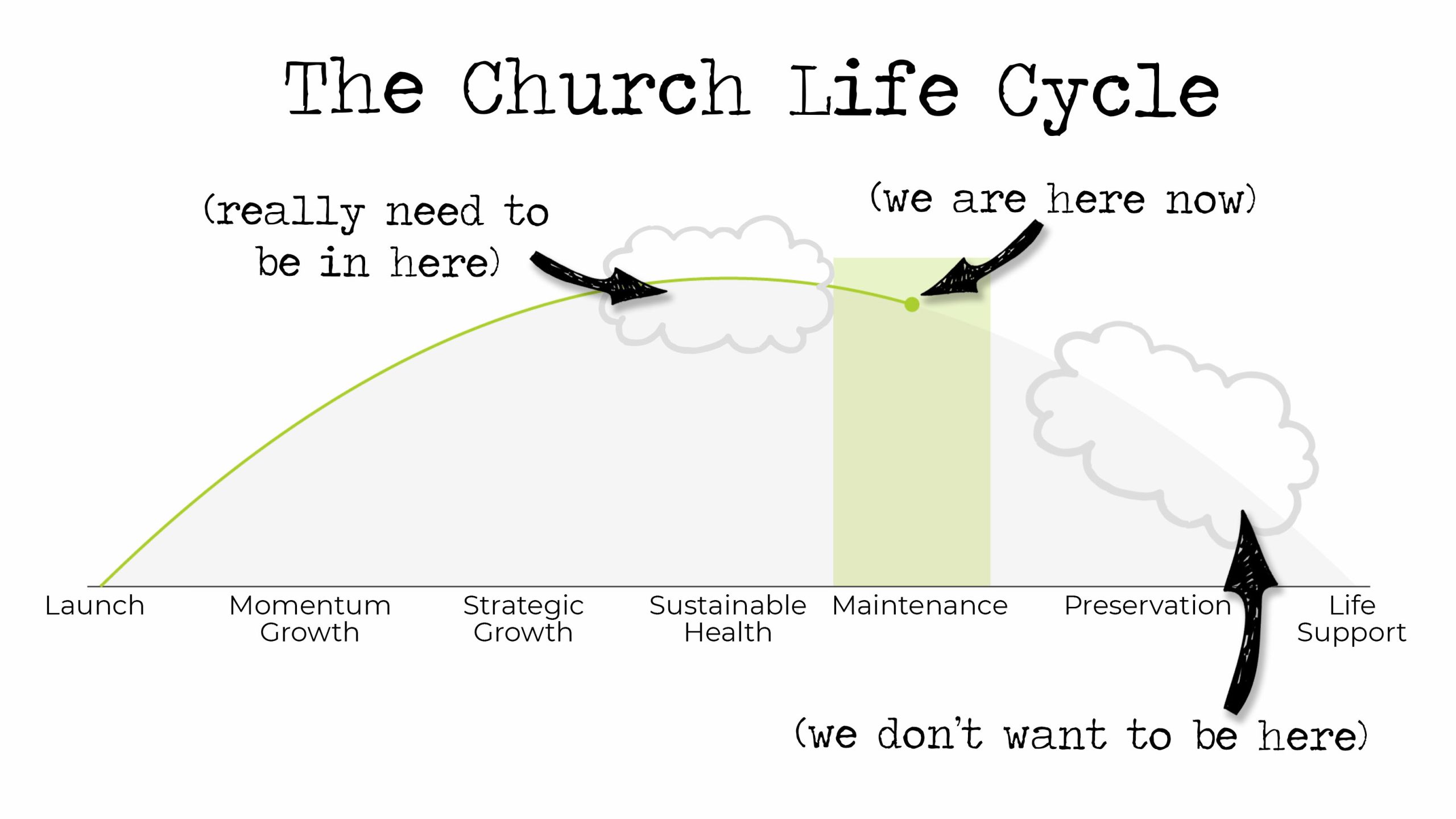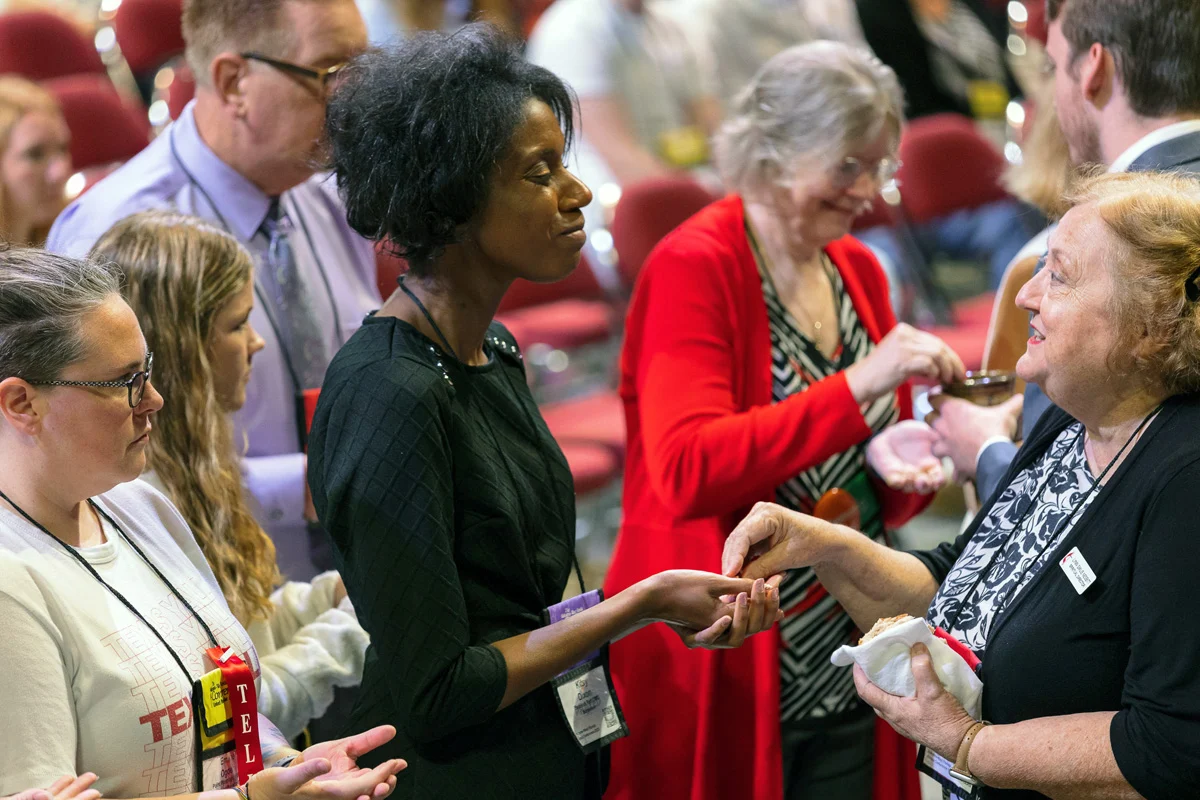In 2019, Riverchase UMC participated in an assessment conducted by the Unstuck Group. According to their website, their goal is to “help pastors grow healthy churches by guiding them through experiences to align vision, strategy, team and action…our priority is to help churches help people meet and follow Jesus.”
The Unstuck Group helps churches find out where their churches are in their church lifecycles. Think of it like a physical, but for churches. They provide an objective assessment back to a church after a congregation completes the surveys.
We sent out the link to take the survey to the congregation in 2019. The 49 questions on the survey were on a ten-point scale. They asked questions about the members’ perceptions of the activities and organizational structures of the church.
Is the church on an upward growth swing?
Is the church in the throes of a decline in vibrance?
Is the church simply maintaining and getting comfortable within its own walls?
The results of the assessment of our church were concerning.
Riverchase UMC was told it was in the “Maintenance” phase of the church’s life
As seen in the graph in this post, the Unstuck Group’s research shows that a church moves through several phases in its life. It can move both forward and backward along the path. The seven phases of a church’s life are:
- Launch
- Momentum Growth
- Strategic Growth
- Sustainable Health
- Maintenance
- Preservation
- Life Support
After all of the data was collected and analyzed, the Unstuck Group determined that Riverchase UMC was in the “Maintenance” phase of its life.
The characteristics of a church in a maintenance phase are defined by the Unstuck Group in this way:
No ministry slips into a Maintenance season intentionally, but this is the path every church drifts toward if intentional steps aren’t taken to avoid it. What’s crazy about this phase is that, on the surface, everything about the church can still appear very healthy. Growth is likely still happening, though at a slower pace. The church may be financially healthier than it has ever been. That said, there will be red flags. The ministries begin to focus more on the people who are already connected to the church than the people they are trying to reach. The focus scale tips toward sustaining systems and structure rather than remaining on the vision. Methods begin to supersede mission.
The general characteristics of a church in a maintenance phase were detailed:
Complexity reigns. There’s a shift toward an inward focus. Leaders control. Traditions are protected. Growth is still happening, though at slower pace. The vision stales.
I can remember when this was presented to our Board of Stewards. I don’t know that it truly resonated the way it should have. We had an independent group (that does this with other churches all over the country) telling us that our church was at an inflection point. It ruffled some feathers — likely because it was something that people were uncomfortable hearing. Yet this was an organization that had conducted over 500 church assessments like this one over its 14 year span with churches from 200 members to 20,000.
Typically, churches that don’t alter course and reimagine themselves continue the downhill arc through the “Preservation” and into “Life Support” phases.
“…a prevailing pull to go back to the way things used to be”
Interestingly, looking at some of the traits of churches in the next phase — “Preservation” — I find a few of these traits currently with us in the church:
6. Preservation Phase
When a church is in the preservation phase…
- Attendance and finances are both declining
- Methods become more important than the mission
- There’s a prevailing pull to go back to the way things used to be
- The strong leaders and visionaries have left the church
- Power shifts from the pastor and staff to the lay leadership
- The focus shifts to keeping people from leaving
I’ve highlighted the third bullet, above, in the “Preservation Phase” characteristics because I’ve seen over the past few years that we have voices that wish we would never change anything about our building, never try new music and never change pastors. They’ve gotten accustomed to the comfort of the walls of the building and would rather let the church wither than try anything new.
Here’s a great example.
The Story of the Sanctuary “Almost TVs”
When the Covid-19 pandemic hit, churches around the world scrambled to figure out how to best serve their congregations while keeping the health of church members forefront. Churches put more into online worship production and looked for ways to reduce common-contact items, such as bulletins and hymnals, to prevent the spread of Covid-19 on surfaces.
At our own church, we thought about ways to prevent people from touching items after one another. Once our Board of Trustees figured out a way to space people out in the sanctuary pews after consulting local medical professionals and referring to guidance at the time, we wanted to bring people back into worship.
But we still had to figure out how to reduce the common-contact opportunities.
We didn’t need to have one service touching hymnals and bulletins and then a second one coming in after and doing the same thing (again, all based on what we knew about the spread of the virus at the time).
The solution suggested was to have a TV mounted on either side of the choir area in the sanctuary. These two screens would then be used to display the words to the hymns, much like the lyrics are presented in the Modern Worship service. As a result, no hymnals would be necessary.
You hear legendary stories about people getting in a stir about the “color of the carpet” at churches and deciding to leave because of it. It’s a funny example of how people can sometimes get focused on the wrong things being important.
TVs were our “new carpet color” that year.
Over a couple of weeks in 2019, while people were dying from a pandemic of the likes we’ve never experienced in our lifetimes, we had people outraged about….TVs.
Emails were flying around about who didn’t like the idea and why, and how we could potentially accommodate them. We even had our Board of Trustees chair trying to come up with options to appease that would lessen their appearance in the sanctuary when they weren’t in use.
The sentiment being shared around was that screens would make the Traditional Service seem just like Modern Worship (and, yes, people really have their passions about keeping the traits of the services separated). I got the feeling that people were worried that we’d be carting in the drum set from the service next door soon after and that the Traditional Service (complete with all of its electrification of visual things) would soon become something that wasn’t “traditional”.
I guess people couldn’t see the possibility of showing Vacation Bible School highlights with all of the children enjoying learning about God in the summer.
I guess people couldn’t imagine seeing the highlights of Discovery Weekend and all of the energy surrounding our middle and high-school youths.
Maybe they couldn’t see the benefit of showing a picture of the baby being baptized or before the service, showing families that have joined the church recently.
TVs in the sanctuary triggered fears of change in our church and that is the attitude that will make Riverchase UMC irrelevant if we don’t strive to adjust it.
Seriously….they were just TV screens, y’all.
It’s Time to Check Ourselves
I don’t fault anyone for having a concern about TVs or change in general. That’s human nature. And discomfort happens.
But our character as a congregation is revealed in how we react and adapt to that discomfort.
When we get to the point that our fears of change create doubt or keep us from being able to worship together as a unified body of Christ, that’s detrimental.
And that leads us to where we are today.
We’re in a “maintenance” phase.
We’re holding on tightly to keep change from happening in areas.
We’re not willing to even put TVs up when it might get people more comfortable coming back into a worship setting together.
And as some church members campaign for pulling us away from the United Methodist Church, keep in mind that as of right now, the United Methodist Church’s doctrines have not changed; they haven’t changed in years.
The irony is that this is a “prevailing pull to go back to the way things used to be”…and nothing has even changed.
We all need to be asking ourselves individually about how we view our church’s future:
- Am I comfortable with Riverchase UMC just “maintaining”?
- Do the ideas of physical building changes or program updates make me feel as though my church’s direction is changing?
- Does it unnerve me to get new pastors and see new leadership changes (note: pastors that move around to build strength for the whole denomination and grow churches is one of the key historical components of Methodism dating back to the 1700s)?
- Am I okay with our church dropping long-time programs and initiatives that might not be as effective anymore even if I enjoyed being a part of them?
How much are we willing to bristle about new worship concepts, to cast aside the needs of the next generation that is already hesitant to be a part of organized religion, and to take a position that makes people leery of our “unconditionally loving” church on Old Montgomery Highway?
The Takeaway
Honestly, I’m not sure we’ve changed the direction that we were headed in when the Unstuck Report was given to us in 2019.
Let’s don’t get comfortable and continue to let ourselves coast downward. Because, after all, once you’re over the hill, it’s pretty easy to let gravity take over and get pulled into a phase of “life support”. We have to ask the honest questions of ourselves about our church’s health and whether complacency will take us fully into the “Preservation” phase.
But the good news is that we can move both forward and backward along the graph and reposition ourselves in the church life cycle.
The greater news is that have people at Riverchase UMC who are passionate about loving and connecting with God in a variety of ways. We have a lot of great things going on and the potential for even more. We are part of a mosaic of United Methodist believers both in our church and around the world.
Still, we can also easily be lured into what feels “safe”.
Our mission is not to simply “maintain”.
Our mission is not to recreate some previous version of Riverchase UMC that seems more comfortable.
Our mission depends on us shifting, adapting, and putting ourselves in uncomfortable situations of redevelopment so we can both nurture and grow disciples that can go out in the community and the world and lead people to Christ.
Don’t let our church get stuck.






